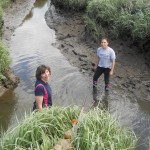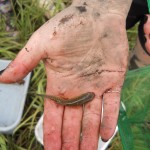(I”m on the left. With a student in a tidal creek in Essex, MA)
I am covered in mud at the end of the day after a field trip with a small class to a salt marsh in Essex. My hands smell of the deep rich sulfur scent of marshes by the sea, of sea wrack and salt water. I sniff deeply and exhale and remember the joy of hundreds maybe thousands of hours spent in marshes both salt and fresh. Hours on days like this, counting minnows, counting larvae invertebrates, mapping vegetation .
In a salt marsh, the mud sucks at your old sneakers, clings to your calves, creeps up your pants. Soft, and thick, it is the life of the marsh. In a tidal creek, I sink to my knees as I move forward slowly, trying to seine minnows. The mud’s richness comes from the death of plants, the trapping of tiny particles, the soft decay of algae. Bacteria quietly grow, using up the oxygen and turning the layers below the very thin top layer, a rich dark color.
Mud is elemental here. It holds the history of the marsh, the tale of hurricanes and storms, the movement forward and back of the constantly changing coast. Crabs sidle by on its surface, ribbed mussels stick out only a bit, filtering the changing tide, cleaning the water from one cycle to the next. Up at the surface, the tough marsh pants will trap mud particles, raising the marsh surface while the processes of sea level rise and decay lower it. Tens of thousands of years of marsh accretion and loss , growing and declining, have brought this place to be. I get to be here, and would have no other place today.Some people are made to revel in mud. I am one, and today is a day for a tidal marsh.


